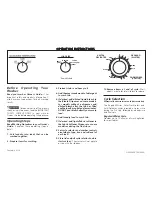
EXPANDABLE 528
D E H Y D R A T O R
Owner’s Manual User Guide
16
Fruit
Fruit
Preparation
Average
Drying
Time/ Hrs
Test for
Dryness
Apples
Peel if desired. Core. Cut slices, rings or chop into pieces
4-10
Leathery, no
moisture when cut
Apricots
Do not peel. Halve and pit. Turn inside out or cut slices.
8-16
Leathery, pliable
Bananas
Peel. Cut into slices 1/8” - 1/4”.
6-12
Leathery, slightly
sticky in the center,
brittle
Firm Skin
Berries
(Blueberries, cranberries, etc) Sort. Poke skin or place in
boiling water for 1-2 min. Blot dry.
10-18
Hard
Berries
Leave whole.
10-18
Hard
Cantaloupe
Cut in half. Remove seeds and peel. Cut slices. Blot dry
on paper towel.
8-20
Leathery, suede-
like
Cherries
Wash, pit and remove stems. Poke skin or place in
boiling water for 1-2 min. Blot dry.
20-26
Citrus Fruit
Peel, if desired. Cut into slices.
6-12
Hard
Coconut
Remove Outer Skin. Slice.
12-16
Cranberries
Wash. Remove stems. Place in boiling water for 1 - 2
min. Blot dry.
14-22
Grapes
Cut in half. Remove seeds. Place cut side up. Seedless
green are better than red or black. Poke skin or place in
boiling water 1 -2 min. Blot dry.
13-36
Raisin-like texture
Kiwi
Peel. Cut into slices. Slice 1/4” - 3/8 thick.
13-17
Mangos
Remove skin and slice.
10-18
Melons
Remove skin and seeds. Use deepest tray for watermelon.
Cut in slices as thick as deep tray size will allow.
12-16
Peaches
Peel, if desired. For easy peeling, dip in boiling water
until skin cracks. Cut in half. Pit. Cut in slices.
6-16
Leathery, may be
slightly sticky in center
Pears
Wash. Peel if desired. Core. Cut in slices or rings.
6-16
Leathery, no
moisture when cut
Pineapple
Remove crown, skin & eyes. Cut in half. Cut in slices, leaving
core in or remove, dice or chop and use Mesh Inserts.
6-12
Pliable, still slightly
sticky. No visible
signs of moisture
Plums
Do not peel. Cut in half. Pit. Turn inside out or cut in slices.
8-16
Leathery, pliable
Rhubarb
Trim. Wash. Slice diagonally into ¾” pieces. Steam 3 - 4
min. Use Mesh Inserts.
6-14
Brittle
Strawberries
Wash. Cut in half. Place cut side up.
6-12
Hard, brittle
NOTE: Dry fruit at 130°-140°. Use average times only as a general guideline.
Variables can contribute to a large difference in drying times. To test for dryness: remove a piece
of fruit. Let it cool. Cut or tear. Fruit should have almost no moisture. Most fruts will still be
pliable and leathery. Bananas and strawberries should be almost crisp. You can leave softer, if
you do not plan on storing for a long time. Store dehydrated fruit in an airtight container.
17
Fruit Leather
FRUIT LEATHER
Pureed fruit dried in thin sheets becomes a tasty, candy-like fruit leather
snack.
• Pit, then puree fruit of your choice, adding just enough liquid (fruit juice or
water) for the blender to puree effectively. Often no liquid is needed.
• Fruit may also be mixed with applesauce. One cup applesauce will
prevent leather from cracking or splitting.
• If fruit is tart, you may also add a sweetener.
• Lightly spray fruit leather sheets with vegetable oil before pouring on
puree to prevent sticking when removing leather. You can also use a little
olive oil. Rub it on a fruit leather sheet with a paper towel.
• Place fruit leather sheet(s) into dehydrator tray(s). Pour one cup of fruit
puree onto a sheet. Remember to leave the drying tray’s center hole
uncovered.
• For adequate circulation, only one half of the drying tray should be used.
Place fruit leather sheets on alternate halves of the trays in the stack.
• After all fruit leather sheets are fi lled, stack the drying trays on the base.
• Set temperature to 135°. Dehydratrate about 8-11 hours, (general rule).
• Rotate fruit leather sheets, (not dehydrator trays), twice during drying
time, (about every 3 hours).
• Leather is done when you notice puree to have a leather texture with no
sticky spots. It should easily remove from the fruit leather sheet.
• Wrap in plastic wrap and store at room temperature or refrigerate.
• Spices, chopped nuts or coconut may be added to the puree for extra
fl avor. For further variation, puree several types of fruit together. Don’t
be afraid to experiment! Vary the amounts according to availability, taste
and imagination. If the puree tastes good, the leather will be better.
Remember the fl avors, and sweetness, concentrate with drying.
Try the following combinations:
• Apples, oranges, bananas and sunfl ower seeds
• Cooked cranberries, oranges and honey
• Raspberries, bananas and coconut
• Strawberries and bananas
• Strawberries, and rhubarb
• Pineapple and peaches
• Raspberries and apples
• Apricots and plums
















































